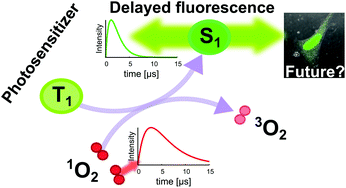Six common water-soluble singlet oxygen (1O2) photosensitizers – 5,10,15,20-tetrakis(1-methyl-4-pyridinio) porphine (TMPyP), meso-tetrakis(4-sulfonathophenyl)porphine (TPPS4), Al(III) phthalocyanine chloride tetrasulfonic acid (AlPcS4), eosin Y, rose bengal, and methylene blue – were investigated in terms of their ability to produce delayed fluorescence (DF) in solutions at room temperature. All the photosensitizers dissolved in air-saturated phosphate buffered saline (PBS, pH 7.4) exhibit easily detectable DF, which can be nearly completely quenched by 10 mM NaN3, a specific 1O2 quencher. The DF kinetics has a biexponential rise-decay character in a microsecond time domain. Therefore, we propose that singlet oxygen-sensitized delayed fluorescence (SOSDF), where the triplet state of a photosensitizer reacts with 1O2 giving rise to an excited singlet state of the photosensitizer, is the prevailing mechanism. It was confirmed by additional evidence, such as a monoexponential decay of triplet–triplet transient absorption kinetics, dependence of SOSDF kinetics on oxygen concentration, absence of SOSDF in a nitrogen-saturated sample, or the effect of isotopic exchange H2O–D2O. Eosin Y and AlPcS4 show the largest SOSDF quantum yield among the selected photosensitizers, whereas rose bengal possesses the highest ratio of SOSDF intensity to prompt fluorescence intensity. The rate constant for the reaction of triplet state with 1O2 giving rise to the excited singlet state of photosensitizer was estimated to be ≳1 × 109 M−1 s−1. SOSDF kinetics contains information about both triplet and 1O2 lifetimes and concentrations, which makes it a very useful alternative tool for monitoring photosensitizing and 1O2 quenching processes, allowing its detection in the visible spectral region, utilizing the photosensitizer itself as a 1O2 probe. Under our experimental conditions, SOSDF was up to three orders of magnitude more intense than the infrared 1O2 phosphorescence and by far the most important pathway of DF. SOSDF was also detected in a suspension of 3T3 mouse fibroblast cells, which underlines the importance of SOSDF and its relevance for biological systems.


 Please wait while we load your content...
Please wait while we load your content...